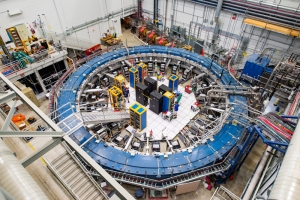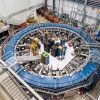Fermilab has announced an exciting measurement of the anomalous magnetic moment of the muon
2021.04.09 9:13 - Marek PawłowskiThe Muon g-2 experiment at the Fermi National Accelerator Laboratory in Chicago announced the first results of measurements of the anomalous magnetic moment of the muon, which support suspicions that this magnitude is not in line with the predictions of the Standard Model. The results are commented on by NCBJ scientists: professor Michał Bluj from the High Energy Physics Division and professors Kamila Kowalska and Enrico Sessolo from the Theoretical Physics Division.
Link to the Fermilab news: https://news.fnal.gov/2021/04/first-results-from-fermilabs-muon-g-2-expe...
Comment by prof. Michał Bluj from the NCBJ High Energy Physics Division, member of the CMS collaborationt at CERN
It is great to see, after nearly two decades, that the new measurement of the anomalous magnetic moment of the muon (g-2) confirms the previously observed deviation from the predictions of the Standard Model of elementary interactions. The new measurement announced by the experiment at the Fermi laboratory in the USA is based on the first sample of data collected in 2018 (Run-1), and its precision is comparable (slightly better) to that of the previous generation experiment, but importantly, the systematic uncertainties burdening it have been significantly reduced. This, combined with the new 2019-2020 data that is being analyzed and the ones currently being collected, will increase the precision of the measurement approximately twice as compared to the previous result, and in combination with all planned data, up to four times. However, with the current precision, we get a strong confirmation (at the level of four standard deviations, i.e. about 1/40000) that the Standard Model must be supplemented, i.e. that we are dealing with new unknown elementary particles or a new type of interactions. However, the measurement of g-2 muon does not provide us with much information about what new particles or interactions could be, which is an exciting challenge for both model-building physicists and experimenters.
Comment by professors Kamila Kowalska and Enrico Sessolo from the NCBJ Theoretical Physics Division
In quantum electrodynamics -- the theory that describes the motion of fermions in an electromagnetic field -- the electron and the other charged leptons (muon and tau) interact with the magnetic field thanks to the magnetic dipole moment, which is proportional to the lepton's spin or intrinsic angular momentum. The strength of this interaction is determined by the so-called g-factor, which classically is a constant exactly equal to 2. Quantum corrections due to the virtual exchange of all the particles present in nature can produce a shift in the g-factor value. This is called the anomalous magnetic moment. Taking into account all the particles of the Standard Model, its value can be determined with the astounding precision of 400 parts per billion. Amazingly, the "Muon g-2" experiment at Fermilab has just measured the anomalous magnetic moment of the muon with a precision comparable to that of the Standard Model calculation. Similarly to a previous experiment at the Brookhaven National Laboratory, the new measurement confirms a more than 3 sigma deviation from the Standard Model prediction. The combined statistical significance of both experiments reaches 4.2 sigma, which means a 99.997% probability of this not being a statistical accident.
If the Standard Model cannot explain the measured value, then there must be New Physics. Particle theorists have developed a large number of models that can explain the muon magnetic moment anomaly. The possibilities are numerous: supersymmetry, leptoquarks, vector-like fermions, new Higgs fields and new gauge bosons. Some of the new particles can be heavy, some other very light and almost invisible, inducing a connection with the mystery of dark matter. Almost all of these scenarios have been investigated by several members of the Theoretical Physics Division at NCBJ. The work ahead of us is exciting, because the theory calls for particles that must be in reach of current and future experiments, but also challenging, as many of the models invoked for an explanation of this anomaly are already under extreme pressure by the strong bounds from direct New Physics searches at the LHC.
Alas, no real party would be complete without someone showing up at the last moment to ruin it. The Standard Model may still have the last word. It is news of yesterday that the BMW (Budapest-Marseille-Wuppertal) lattice QCD group, which specializes in calculating numerically fundamental quantities from the properties of Quantum Chromodynamics (QCD) has found that one of the QCD contribution to the anomalous magnetic moment of the muon might be much larger than previously thought, and therefore it might be able to accommodate the freshly measured experimental value. (https://www.nature.com/articles/s41586-021-03418-1)
New contributions from the Standard Model or New Physics beyond the Standard Model? Whichever it may be, the Fermilab measurement remains a historical milestone. It is now to us theorists to find the final answer.


















